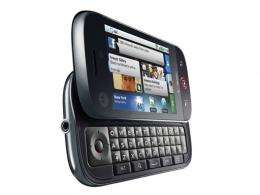The Cliq may raise the bar for smart-phones

Motorola may have provided a glimpse of the next stage in the evolution of the smart-phone.
At a conference in San Francisco last week, the venerable but struggling mobile phone maker debuted the Cliq, a smart-phone based on Google's Android operating system. What was neat about the Cliq was its whole new take on how consumers should use and interact with their phones.
Most smart-phones have a home screen that borrows a lot from the PC world. Typically, it either looks a lot like a desktop or a folder full of program icons -- or some combination of the two. Such designs reflect that a smart-phone is at base a computing device on which you can run a bunch of different applications.
The Cliq, to be released later this year, has a completely different slant on the purpose of a smart-phone. It's built around the back-to-the-future idea that smart-phones are at base communications devices. And what makes a smart-phone so powerful is its ability to easily connect users to different communications services at the same time.
Motorola has put modern communications front and center on Cliq with a feature called Motoblur, which is built on top of Android. From the Cliq's home screen, users can update their status on Facebook or Twitter. In a separate window on the same screen, they can see status updates, instant messages, e-mail and other communications sent by friends and contacts from a variety of sources.
And users will find multiple ways of contacting friends from address book entries gleaned from a wide range of different places, including social networks, enterprise e-mail servers and instant messaging services.
Some of this already can be done on other smart-phones. One of the best features of Palm's webOS, which is built into its new Pre smart-phone, is a service called Synergy, which combines address book and calendar data from a limited _ but growing _ set of online sources. Meanwhile, consumers using the Beejive application for the Apple iPhone can connect to multiple instant messaging services at one time, and those using the ShoZu program can upload pictures to multiple sites at once.
But with Motoblur, the Cliq takes these ideas to the next level, connecting to many more sites and services. It goes the furthest in tying a smart-phone to the fast-growing world of social networking.
I have no idea whether the Cliq will be successful in the marketplace. Because Motorola is launching the device exclusively on T-Mobile, which is dwarfed in size by AT&T and Verizon, the device will have a limited potential audience for now.
I've not yet played with the device, so I can't say how well the Motoblur service will work. Such a service could become overwhelming or annoying, particularly if you can't easily filter out or sift through all the messages coming your way.
Even it fails to catch on, the Cliq is exciting because it's the first Android device I've seen that shows the flexibility and potential of the operating system. It proves that manufacturers and developers can use Android to create devices that are truly innovative.
But I'm betting that the Cliq will be a success. The idea of combining data from different communications services and allowing you to access them all at once in an easy-to-use interface makes a lot of sense -- and makes me envious.
Two applications I use frequently on my iPhone are its e-mail client and Facebook. Being able to see pertinent messages from both in one place would be great. And I wish my iPhone had something like Synergy or Motoblur that would show me in one place all the contact information I have access to from my friends.
I'm guessing such features -- or even better ones -- may not be far off. One of the great things about the smart-phone business these days is the competition. Innovations are happening rapidly and are being copied quickly by competitors.
In the wake of the iPhone's success, rivals quickly moved to offer touch-screen phones and fully capable mobile Web browsers. Apple's success with its application store has made such marketplaces an expected feature of all new smart-phones.
If the Cliq gets any kind of traction, you can bet that others will be quick to copy or try to one-up it, too.
__
(c) 2009, San Jose Mercury News (San Jose, Calif.).
Visit Mercury Center, the World Wide Web site of the Mercury News, at www.bayarea.com/mld/mercurynews
Distributed by McClatchy-Tribune Information Services.



















